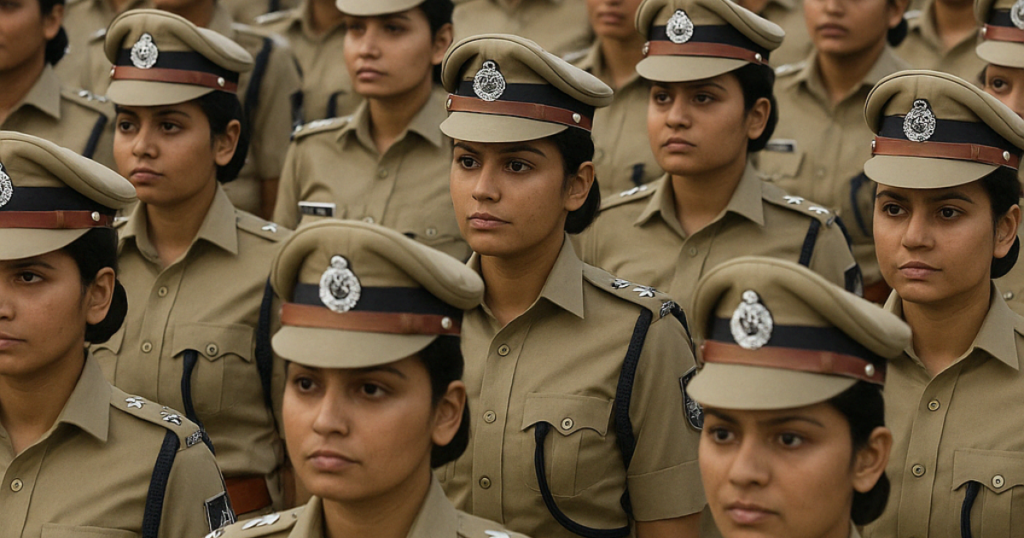India’s police force continues to reflect deep gender disparity, with only 8 percent of officers being women, according to the India Justice Report 2025 released on Tuesday.
Out of over 3 lakh police officers in the country, only 25,282 are women.
- 52% of women officers are sub-inspectors
- 25% serve as assistant sub-inspectors (ASIs)
- Just 13% are constables
- Only 12% of Indian Police Service (IPS) officers are women
These figures, current up to January 2023, highlight how women remain concentrated at the bottom levels of the police hierarchy, with little presence in top-ranking posts.
What’s Holding Women Back in the Police?
Former IPS officer Kiran Bedi attributes the low representation to a mix of social, cultural, and systemic barriers.
“There is still a strong perception that policing is a male-dominated profession, requiring physical strength and long, unpredictable hours,” Bedi told ThePrint.
She says this deters many families from encouraging women to join the force, especially in rural India.
Bedi also flagged infrastructure issues as a major deterrent:
- Lack of secure housing
- Inadequate sanitation facilities
- No childcare support
- Unsafe or unsupportive work environments
According to her, even recruitment campaigns targeting women are infrequent and poorly executed, and once hired, women often face limited mentorship and slower career growth.
She recommends exploring new pathways, such as an Agniveer-style model for policing:
“Why not try an Agniveer concept for the police constabulary for young women? Catch them young. Retain those who want to continue and release those who don’t.”
States with Better Numbers—and Those Falling Behind
The national average hides some important differences between states.
- Bihar leads with 24% women in the police, the highest in the country
- Bihar also saw the most improvement, up from 21% in 2022
- However, nine states and UTs, including Telangana, Madhya Pradesh, and West Bengal, have seen a decline
As of January 2023, the overall women’s share in the police (across civil police, District Armed Reserve, Special Armed Police, and Indian Reserve Battalions) stood at 12.3%, up slightly from 11.7% in 2022.
But progress is slow.
- At the current rate, Bihar and Andhra Pradesh could hit the 33% benchmark in about 3 years
- Jharkhand, Tripura, and Andaman & Nicobar Islands could take up to 200 years
Women in the Judiciary: Progress at the Bottom, Gaps at the Top
The gender gap extends beyond police forces.
The judiciary shows a similar pattern: more women at the trial court level, but very few in the high courts.
- 38% of judges in lower judiciary are women
- Only 14% of high court judges are women
As of March 2025, 27 states and UTs have reached or crossed 33% women judges in district courts.
Seven states have 50% or more women at the lower court level.
But only Telangana and Sikkim have more than 30% women judges in their high courts.
Uttarakhand has no women in its high court bench.
Why Aren’t More Women Elevating to High Courts?
Senior advocate Geeta Luthra explains that high court judges are mostly drawn from the senior bar. Many women lawyers are only now reaching the required 15–20 years of practice to be considered for elevation.
“The judiciary used to be a very conservative male space. That’s changing, but it will take time for women to catch up.”
She notes that earlier, even well-qualified women were passed over due to gender bias.
“That ceiling is starting to break. But women need time to rise through the ranks.”
Just Hiring Women Isn’t Enough
Former IPS officer Meeran Chadha Borwankar agrees that states are trying to recruit more women. She cites 30% or more reservation for women in many police forces, with special drives in states like Bihar.
But recruitment alone won’t solve the problem.
“A 2016 study of Maharashtra Police showed that many women officers lacked proper training and infrastructure. They also struggled with support from male colleagues,” Borwankar said.
She stressed the need to:
- Invest in gender-sensitive training
- Improve infrastructure and living conditions
- Conduct sensitization programs for male officers
Can India Close the Gender Gap in Justice?
The India Justice Report 2025, a collaborative effort by six organizations including CHRI, DAKSH, Vidhi Centre for Legal Policy, and TISS-Prayas, paints a sobering picture.
Despite incremental progress, structural inequalities remain.
Questions that need answers:
- Why is women’s representation still so low in senior positions?
- What practical steps can states take beyond recruitment?
- How can institutions ensure equal opportunity and career progression?


